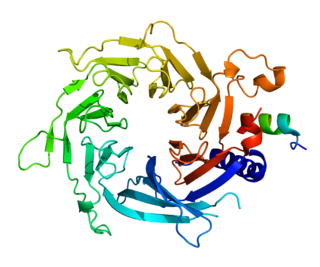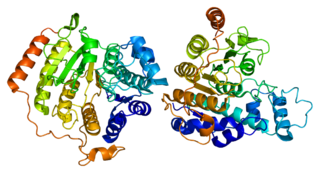Histone-binding protein RBBP4 (also known as RbAp48, or NURF55) is a protein that in humans is encoded by the RBBP4 gene. [5] [6]
Histone-binding protein RBBP4 (also known as RbAp48, or NURF55) is a protein that in humans is encoded by the RBBP4 gene. [5] [6]
This gene encodes a ubiquitously expressed nuclear protein that belongs to a highly conserved subfamily of WD-repeat proteins. It is present in protein complexes involved in histone acetylation and chromatin assembly. It is part of the Mi-2/NuRD complex that has been implicated in chromatin remodeling and transcriptional repression associated with histone deacetylation. This encoded protein is also part of corepressor complexes, which is an integral component of transcriptional silencing. It is found among several cellular proteins that bind directly to retinoblastoma protein to regulate cell proliferation. This protein also seems to be involved in transcriptional repression of E2F-responsive genes. [7]
A decrease of RbAp48 in the dentate gyrus (DG) of the hippocampus in the brain is suspected to be a main cause of memory loss in normal aging. [8] An age related decrease in RbAp48 is observed in the DG from human post-mortem tissue and also in mice. Furthermore, a gene knockin of a dominant negative form of RbAp48 of causes memory deficits in young mice similar to that observed in older mice. Finally lentiviral gene transfer to increase the expression of RbAp48 in the brain reverses memory deficits in older mice. [8]
RBBP4 works at least in part through the PKA-CREB1-CPB pathway. [8] Hence one possible therapeutic approach to restore age-related memory loss is the use of PKA-CREB1-CPB pathway stimulating drugs. It has previously been shown that dopamine D1/D5 agonists such as 6-Br-APB and SKF-38,393 that are positively coupled to adenylyl cyclase and the cAMP phosphodieserase inhibitor rolipram reduce memory defects in aged mice. [9]
RBBP4 has been shown to interact with:

Histone deacetylase 1 (HDAC1) is an enzyme that in humans is encoded by the HDAC1 gene.

The nuclear receptor co-repressor 1 also known as thyroid-hormone- and retinoic-acid-receptor-associated co-repressor 1 (TRAC-1) is a protein that in humans is encoded by the NCOR1 gene.

Histone deacetylase 2 (HDAC2) is an enzyme that in humans is encoded by the HDAC2 gene. It belongs to the histone deacetylase class of enzymes responsible for the removal of acetyl groups from lysine residues at the N-terminal region of the core histones. As such, it plays an important role in gene expression by facilitating the formation of transcription repressor complexes and for this reason is often considered an important target for cancer therapy.

Histone deacetylase 3 is an enzyme encoded by the HDAC3 gene in both humans and mice.

Paired amphipathic helix protein Sin3a is a protein that in humans is encoded by the SIN3A gene.

Transcription factor E2F4 is a protein that in humans is encoded by the E2F4 gene.

Histone deacetylase 4, also known as HDAC4, is a protein that in humans is encoded by the HDAC4 gene.

Histone H4 is a protein that in humans is encoded by the HIST4H4 gene.

Methyl-CpG-binding domain protein 2 is a protein that in humans is encoded by the MBD2 gene.

Histone-binding protein RBBP7 is a protein that in humans is encoded by the RBBP7 gene.

Myocyte-specific enhancer factor 2A is a protein that in humans is encoded by the MEF2A gene. MEF2A is a transcription factor in the Mef2 family. In humans it is located on chromosome 15q26. Certain mutations in MEF2A cause an autosomal dominant form of coronary artery disease and myocardial infarction.

Histone deacetylase 5 is an enzyme that in humans is encoded by the HDAC5 gene.

Sin3A-associated protein, 30kDa, also known as SAP30, is a protein which in humans is encoded by the SAP30 gene.

Chromodomain-helicase-DNA-binding protein 4 is an enzyme that in humans is encoded by the CHD4 gene. CHD4 is the core nucleosome-remodelling component of the Nucleosome Remodelling and Deacetylase (NuRD) complex.

Lysine-specific demethylase 5A is an enzyme that in humans is encoded by the KDM5A gene.

SWI/SNF-related matrix-associated actin-dependent regulator of chromatin subfamily D member 1 is a protein that in humans is encoded by the SMARCD1 gene.

MAD protein is a protein that in humans is encoded by the MXD1 gene.

Histone deacetylase 8 is an enzyme that in humans is encoded by the HDAC8 gene.

The retinoblastoma protein is a tumor suppressor protein that is dysfunctional in several major cancers. One function of pRb is to prevent excessive cell growth by inhibiting cell cycle progression until a cell is ready to divide. When the cell is ready to divide, pRb is phosphorylated, inactivating it, and the cell cycle is allowed to progress. It is also a recruiter of several chromatin remodeling enzymes such as methylases and acetylases.
In the field of molecular biology, the Mi-2/NuRDcomplex, is a group of associated proteins with both ATP-dependent chromatin remodeling and histone deacetylase activities. As of 2007, Mi-2/NuRD was the only known protein complex that couples chromatin remodeling ATPase and chromatin deacetylation enzymatic functions.
{{cite web}}: External link in |work=